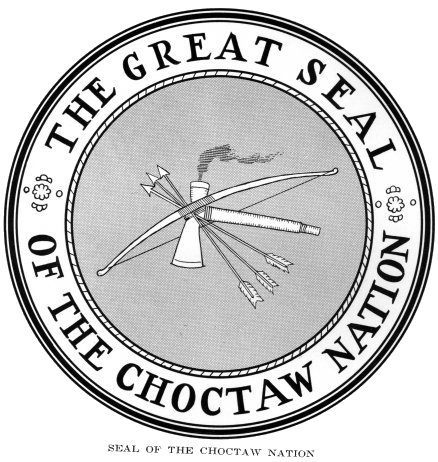
|Home|Contents|Factions|Witchcraft|History|Society|Redbird
Smith|Religion|Spirituality|Prophecy|Genealogy|Links|Discussion|Site
map|

Chronicles of Oklahoma
from
http://digital.library.okstate.edu/chronicles/v018/v018p357.html
Volume 18, No. 4
December, 1940
OFFICIAL SEALS OF THE FIVE CIVILIZED TRIBES
Members of the Five Civilized Tribes were honored this year by an unusual invitation from the Alabama Department of Archives and History through its Director, Mrs. Marie Bankhead Owen. Planning the dedication of the Hall of Flags in its handsome new historical building at Montgomery, the Alabama Department of Archives and History arranged a special Flag Day program for June 14th. At this time, different patriotic organizations in the State would present their State Department of History with the flags of all the nations that had at any period held dominion over the country within the boundaries of Alabama.
Before the first cession of lands in what is now Oklahoma to the Eastern Indians, beginning one hundred and twenty years ago, the Choctaw, Chickasaw, Creek, Seminole, and Cherokee nations claimed portions of Alabama as a part of their ancient homelands. In the history of Oklahoma, these Indian nations are often referred to as the "Five Civilized Tribes." It was to honor the ancestors and to memorialize the achievements of the Indian people that the Alabama Department of Archives and History invited the members of the Five Civilized Tribes to present the flags of their governments during the dedication exercises.
The invitation immediately brought up a question since none of the Indian nations ever officially adopted a separate flag of its own. The American flag—"Old Glory"—always floated over the Government buildings and, on stated occasions, over the Indian capitols in the Indian Territory. An exception to this was during the War between the States, the five Indian nations having made treaties of alliance with the Confederate States. For four years, as the fortunes of war shifted with fighting and conquest, the Confederate flag marked the military camps and forts garrisoned by Confederate troops and their Indian allies in this part of the west.1
Upon receipt of Mrs. Owen's invitation sent through the auspices of the Oklahoma Historical Society, Secretary James W. Moffitt telephoned the writer of this article for suggestions in replying to the letter. In the hope that this invitation so signally honoring the Indian people might be accepted and knowing that no special flags had ever been officially adopted by the Indian governments, the writer suggested that, in place of flags, banners be presented the Alabama Department. All five of the banners should be uniform in size and general design, having white fields surmounted at center with the respective seals of the nations, done in colors. The Great Seal of each nation symbolized its ancient traditions and its history. The white field would represent peace and union with the Indian people; it would represent the new country ceded them over a century ago in what is now Oklahoma, where the Indian "Ships of State" charted a new course in their governments.
Plans for the banners were forwarded through the co-operation of Mrs. Owen, Alabama's Director, and Judge Robert L. Williams, President of the Oklahoma Historical Society, as well as Secretary Moffitt. Special committees representing each of the Indian nations were immediately appointed and gave their enthusiastic support. Active committee members were: Chickasaw Committee, Mrs. Jessie E. Moore and the Chickasaw Governor, Floyd Maytubby; Creek, John Davis; Cherokee, J. B. Milam; Seminole, Mrs. Wm. S. Key: Choctaw, Principal Chief Wm. A. Durant and Muriel H. Wright.
The writer supplied descriptions of the Indian seals, besides her time and efforts for the special research. The laws providing these seals in the Chickasaw, Choctaw, and Cherokee nations were located in the Oklahoma Historical Society. Through the co-operation of the office of A. M. Landman, Superintendent of the Five Civilized Tribes Agency, original impressions of the seals were made on gold leaf with the old dies located in the Indian records at Muskogee.
From the original impressions of the seals, copies of the Indian laws, and other data, Mr. Guy C. Reid, of Oklahoma City, donated
paintings of each of the seals from his drawings enlarged to scale and hand done in water color.
Following the suggestions made by the writer, approved by the Indian committees and those co-operating in the plans, an Oklahoma manufacturing company by special request from the Indian committees produced beautiful banners, copying the paintings of the seals for the central designs. These banners were of white satin, trimmed with gold braid and fringe, having replicas of the seals embroidered in colors. The banner of each nation had its name in large letters at the top, the seal in the center, and below this the words "In Oklahoma," followed by the date of the first land cession to the nation in the Indian Territory.
On Flag Day, June 14, 1940, these Indian banners were presented to Alabama's Hall of Flags. The dedication ceremonies were impressive, attended by a large gathering of Alabama citizens, representatives of the patriotic organizations mentioned above, and Indian delegations from Oklahoma.
Leaving Oklahoma City by automobile early Wednesday morning, June 12th, the journey to Montgomery was made in twenty-four hours of travel. Recalling the stories of how their ancestors had come west during the Indian Removal to the Indian Territory (1830-40), the delegates noted with interest hills and dales, glimpses of moss hung forests and of dense swamp lands, the mighty Mississippi River, and many noted landmarks as they sped past along modern highways. These same scenes bound in primitive and forbidding solitude had been viewed by their ancestors as they traveled on foot and on horseback to the West, blazing the pioneer trails for some of these same roads through the wilderness of that time. How different was their journey requiring many weeks along these routes more than a hundred years ago, compared with the journey to-day!
The visit in Alabama reflected honor and respect for the people of the Five Civilized Tribes of Oklahoma, at the same time afforded much pleasure for, the Indian delegates. Every courtesy and gracious attention were extended by Mrs. Owen, members of the staff of the Alabama Department of History, State officials, and the citizens of Montgomery. Special mention should be made of
the interesting tour of historic sites in this capital city, conducted through the kindness of Mr. Peter A. Brannon, archeologist and member of the staff of the Alabama Department of Archives and History. For most of the delegates, this was the first visit to the historic South and the ancient homelands of their Indian nations. There is so much of human interest alike for the people of Oklahoma and Alabama in their history, present associations, and hopes for the future.
Tradition and history are found in the great seals of the Five Civilized Tribes. All five of the seals have a prominent place in the Great Seal of the State, and are described in Article VI, Section 35, of the Oklahoma Constitution.2
Oklahoma being the 46th star in the American flag, the device of the State Seal centers in a large five-pointed star, outside and between the rays of which are five groups of nine stars each,
representing the other forty-five stars in the national emblem. In the center of the large star is the official seal of the Territory of Oklahoma and in the five rays, the Indian seals.3 In the upward ray is the Great Seal of the Chickasaw Nation. Within the other rays, reading in order from left to right, are those of the Cherokee, Creek, Seminole, and Choctaw nations.
When relating the story of their seals, the term "tribe" is a misnomer in referring to these five Indian governments. For seventy-five years, beginning in 1830 west of the Mississippi, they were spoken of as "nations," since they owned large areas of the country and were organized as separate republics within the present boundaries of Oklahoma. Hence a great seal was needed by each nation for stomping its official papers.
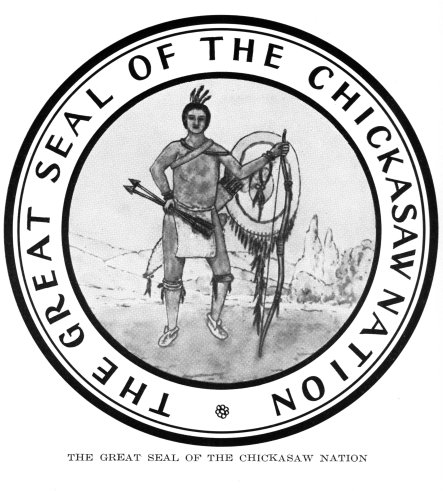
The Great Seal of the Chickasaw Nation showed an Indian warrior standing in ancient regalia, carrying two arrows in his right hand, a long bow in his left, and a shield on his left shoulder.
The two arrows in the warrior's right hand represented his guard over the two ancient phratries or tribal divisions, in which all Chickasaw clan and house names originated. These two phratries were called respectively, "Koi" and "Ishpani" in the native language. In the ancient tribal organization, the hereditary ruler or chief of the Chickasaws was selected from the Ishpani division.
It seems his assistant, the tribal war chief who was often more influential and powerful than his superior, was selected from the Koi division.
In historical records, the Chickasaws were referred to as a nation noted for intrepid warriors, unconquered in battle. According to old tribal lore, the bow and the shield in the Great Seal represented the insignia of the Chickasaw warrior, by right of his descent from the "House of Warriors." This organization was sometimes called the "Tiger Clan" (i. e., Koi Clan or Division), which counted its members from more than one Indian tribe long before the Europeans came to the shores of America.
The Great Seal of the Chickasaw Nation was provided in a constitution adopted in the nation, on August 30, 1856.4 Under the terms of the Treaty of 1855, sponsored by the United States, the Chickasaws had separated from the Choctaws and organized their own government as the "Chickasaw Nation." The constitution and the laws were sent to Louisiana to be printed. Strangely, the person with whom the documents were entrusted lost them en route and they were never found. This necessitated the re-adoption of the constitution and laws at a later date.
In 1856, the capital of the nation was called "Tishomingo City," honoring the name of Chief Tishomingo, the last assistant chief (i. e., war chief) of the old tribal regime in power before the Chickasaws purchased a home among the Choctaws in the West and moved from Mississippi to the new country.
At the age of ninety-six, Chief Tishomingo had been honored by his tribesmen, with a life pension from their national funds "as a token of their kind feelings for him, on account of his long and valuable services." This provision appeared in the Treaty of Pontotoc, in 1832, which set forth the plans for the sale of all Chickasaw lands east of the Mississippi River. The name of this venerable chief has been perpetuated in Oklahoma by that of the present city
of Tishomingo, county seat of Johnston County and location of the old Chickasaw capitol.
With the adoption of the Great Seal of the Chickasaw Nation, the figure of the warrior in the device commemorated the courageous Chickasaw of olden times, represented in the person and character of Chief Tishomingo.5
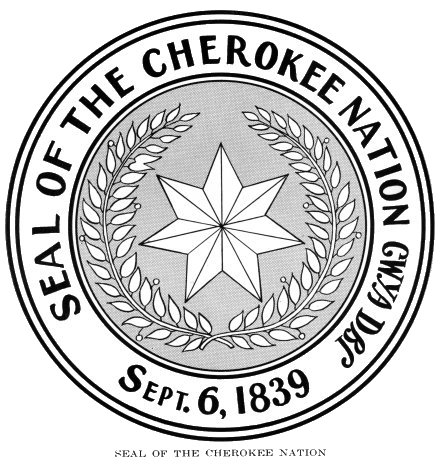
In the center of the Seal of the Cherokee Nation was a large seven-pointed star surrounded by a wreath of oak leaves. The outside border of this device bore the words, "Seal of the Cherokee Nation." Two words for "Cherokee Nation" in the Cherokee language followed, printed in characters from the Sequoyah alphabet and pronounced "Tsa-la-gi-hi A-ye-li." At the lower edge of the seal was the date "Sept. 6, 1839," that of the adoption of the constitution of the Cherokee Nation West.6
Interpretation of the device in the seal is found in Cherokee folklore and history. Ritual songs in certain ancient tribal ceremonials made reference to seven clans, the legendary beginnings of the Cherokee people. A sacred fire was kept perpetually burning in the "Town House" at a central point in the nation. The live oak, the principal hardwood timber in the old Cherokee country in the Carolinas, was used in keeping the sacred fire. Thus, in connection with this fire, the oak was a symbol of strength and everlasting life.
The seven-pointed star in the Cherokee Seal represented the seven ancient clans in tribal lore. Since the oak tree was associated with the mysteries of the sacred fire, the wreath of oak leaves was a symbol of the dauntless spirit of a courageous, virile people.
When first organized under a constitutional form of government east of the Mississippi, the Cherokee Nation planned to preserve its national history and found a museum. In 1859, the Baptist missionaries, Reverend Evan Jones and his son, John Jones, promoted the organization of a secret society, called the Keetoowah, among the fullblood Cherokees. Members sought the preservation of Cherokee history and the development of high ideals of individualism. During the War between the States, the Keetoowah sided with the Union.
The Seal of the Cherokee Nation was adopted by law of the National Council and approved by Lewis Downing, Principal Chief, on December 11, 1871. Lewis Downing had begun his work as a Baptist preacher among his people two years before the adoption of the Cherokee constitution, 1839. During the War between the States, he was commissioned lieutenant-colonel of the Third Indian Home Guard Brigade in the Union Army.
In 1867, Colonel Downing was first elected principal chief of the Cherokee Nation. In that year, when old factional and political strife threatened to disrupt the nation, Reverend Evan
Jones and his son succeeded in furthering the organization of the Downing Party, an alliance between members of the former Ross Party (Union sympathizers) and the ex-Confederate Cherokees. From this time, until the close of the Cherokee Government just before Oklahoma became a State, the Downing Party elected all the principal chiefs in the nation, except one.
In 1869, Colonel Downing was re-elected for a second term as principal chief. The Seal of the Cherokee Nation adopted by the National Council in this year reflected his influence and his associations among his people. One of the darkest chapters in the history of the Cherokees, resulting from the War in the States, had recently, closed. The mystic seven-pointed star and the wreath of oak leaves in the seal, surrounded by the name of the Cherokee Nation both in English and in Sequoyah characters, together with the date of the adoption of the constitution west, formed a symbol of great promise. It heralded a "Glorious Return" of the united Cherokees pledging their devotion to the highest ideals in their educational, industrial, and religious life as a Christian people.7
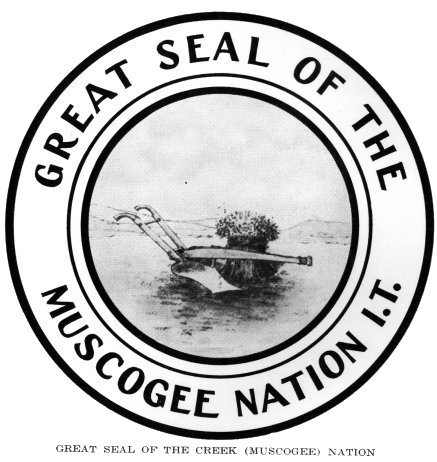
The Great Seal of the Creeks or Muscogees, the latter name used in referring to themselves, showed a sheaf of wheat and a plow in the center of the device surrounded by the words, "Great Seal of the Muscogee Nation, I. T."
Adopted by their National Council after the War between the States, this seal was a modern symbolism of the industry of the Creeks as agriculturists, for which they were noted from earliest times. After coming to the Indian Territory, the successful growing of small grain, especially wheat and some oats and rice, besides large crops of corn in the rich lands bordering the Canadian and the Arkansas rivers and their tributaries, brought prosperity to the Creek people. Connected with ancient tribal customs, the "green corn dance" was celebrated in summer as a thanksgiving and rejoicing in the new crops and marked the beginning of the new year in the nation.
The sheaf of wheat and the plow in the center of the device had a broader significance reflecting Christian influence of the Creek chiefs and leaders. The Methodist and Presbyterian denominations were particularly strong in the nation. From the adoption of the written constitution of the Muscogee Nation in 1867, to the close of this government just before Oklahoma became a State, these two church organizations counted outstanding leaders and principal chiefs as members. Among them were such prominent chiefs as Samuel Checote, Joseph M. Perryman, Legus C. Perryman, and Pleasant Porter.8
A Biblical interpretation of the sheaf of wheat in the Muscogee Seal may be found in Joseph's dream (Genesis 37:7): "For, behold, we were binding sheaves in the field, and, lo, my sheaf arose, and also stood upright...."
An interpretation for the plow may be found in the prophecy (Amos 9: 13): "Behold, the days come, saith the Lord, that the plowman shall overtake the reaper..."
The Seal of the Seminole Nation was adopted during a late period of Seminole history in the Indian Territory. The device showed a plumed tribesman paddling a canoe across a lake to a village, a factory (trading house) standing near the shore.
Originally a tribal division of the Creek Nation, the Seminoles separated from the Creeks and located in Florida about the middle of the 18th Century. From this time, the lakes and swamps of that region had a significant place in the life of the Seminoles.
Refusing to come west during the main removal of the Indians, it was in the swamps of the Everglades that the Seminole families found refuge while their warriors fought for seven years against the United States troops. Though most of the Seminoles were finally forced to move to the Indian Territory, some of them remained in Florida where their descendants have lived to this day, adapting themselves to life in the swamps. When a group of these people in their gayly colored native costumes is seen in the distance approaching through the forest, they appear as a flock of brilliantly plumed birds. Until recently the Florida Seminoles maintained that they were still at war with the United States. Now, however, they no longer hold to this idea. Under the Indian Reorganization Act of 1934, lands including some of their native swamps in Florida have been purchased for their use and their tribal communities established to promote the welfare of this interesting Indian group.
In the West, the Seminoles progressed along the lines of the other Indian nations, though their adoption of republican forms of government was retarded since the permanent location of their lands was not definitely settled until after the War between the States. By the Seminole Treaty of 1866, they purchased a tract of country, the boundaries of which corresponded with those of present Seminole County, Oklahoma. From that time, this region was known as the Seminole Nation and Wewoka was the capital, the National Council meeting annually in the council house erected at this place. Citizens living in fourteen communities throughout the country selected a principal chief of the nation and elected members to the National Council. A unique feature and the pride
of the Seminole government was the efficient body of lighthorsemen who kept strict law and order throughout the nation.
There was a tradition that the design of the official seal of the Seminole Nation was based on old tribal religious beliefs as well as real history. Medicinal herbs and roots were purchased for the manufacture of commercial tonics, by traders among the Indians living in easy access to the places where such plants grew near lakes and streams in Florida and the Indian Territory. In early days, this trade was brisk bringing in considerable revenue during certain seasons of the year.
The knowledge and use of some specially valuable herbs and roots were held sacred by the Creeks and Seminoles, in connection with their ancient tribal religious rites and ceremonials. These ideas governed the whole procedure of gathering and preserving the plants, as well as the journey in taking the dried products to the trading post. Thus, the procedure followed a definite pattern or set of rules and was associated with thoughts of happiness and well-being. In adopting an official seal for the nation west, the scene of the plumed tribesman paddling a canoe across a lake to a village and a trading post suggested for the old time Seminole, a design representing some of the early customs having to do with peace and plenty.
Following an old tribal law, the chief executive of the Seminole people was a hereditary chief or his kinsman selected to rule for life or, in later history, for successive terms during a long period of years. Since the Seminole was a small nation, its government was an example of one man rule. Significant of this, the outer border of the official seal was inscribed with the words "Executive Department of the Seminole Nation."
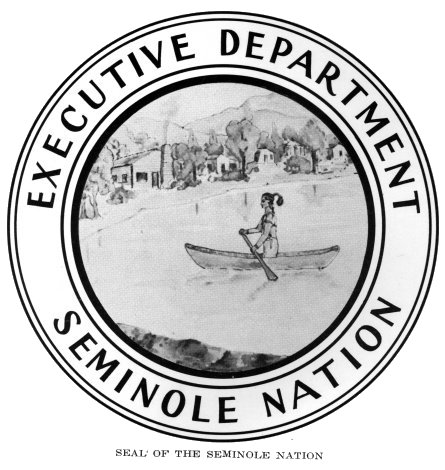
Provisions for an official seal for the Choctaw Nation were made in a new constitution adopted by a convention of Choctaw citizens meeting at Skullyville, in January, 1857. Bitter opposition to the action of the convention almost resulted in a civil war. There were strong objections to the changes made in the executive department, the Skullyville constitution containing a provision for the election of one chief executive to be called "Governor," in-
stead of three chiefs, one for each of the three districts into which the Choctaw country was divided for governmental purposes.
An overwhelming vote of the people in a called election brought about the adoption of another constitution in a convention of elected delegates meeting at Doaksville in January, 1860. This was thenceforth known as the "Doaksville Constitution," remaining in force and effect until the close of the Choctaw government as a separate republic just before Oklahoma became a State. Under this constitution, the executive department of the Choctaw Nation consisted of a "principal chief," with the three district chiefs continued in a subordinate and advisory capacity.
The first cession of lands in present Oklahoma by the United States to any of the Indian tribes living east of the Mississippi was made to the Choctaws, in the Treaty of 1820. The signers of this document in their behalf were three of their most noted chiefs in the history of this people; —Mosholatubbee, Apuckshenubbee, and Pushamataha. Under the early tribal government, the Choctaw country east, included three districts, each ruled by a chief, the three chiefs together forming the executive power in the tribe. After the organization of the nation west as a republic, the new country was again divided for the purpose of government, into three districts and named respectively, Mosholatubbee, Apuckshenubbee, and Pushamataha. From that time, the names of these great leaders were honored and perpetuated in the nation until the close of the Choctaw government just before Statehood.
In the regular annual session of the Choctaw General Council meeting at Doaksville, a special act of October 24, 1860, approved by George Hudson, Principal Chief, defined certain duties of his office. Section 4 of this Act stated in part.9
"The Principal Chief shall procure, at an early day, at the cost of the Nation, a great seal of the Nation, with the words 'The great Seal of the Choctaw Nation,' around the edge, and a design of an unstrung bow, with three arrows and a pipe-hatchet blended together, engraven in the centre, which shall be the proper seal of this Nation until altered by the General Council, with the concurrence of both Houses thereof."
Passing around and smoking the calumet or pipe in council when deliberating important matters for the tribe were parts of special ceremonial among the Indian peoples of America. This custom was particularly significant among the Choctaws who were noted in history for their diplomacy and discussion of tribal affairs in council. Therefore, the pipe-hatchet in their Great Seal represented these old national characteristics.
In ancient times, calumets were purely ceremonial, having carved pipe bowls of red or black stone and stems decorated with bird feathers and sometimes rare furs. Calumets for peace councils were decorated with white feathers and those for war, with red. Foreign traders introduced another kind of pipe manufactured specially for the Indian trade in war minded Europe. This pipe made like a hatchet with a blade, referred to as the "pipe-hatchet," in time took the place of their ancient ceremonial calumet in some Indian tribes.
Though a peaceable people, the Choctaws were noted for great strength in defending their homes and country, the nation having produced many great warriors in historic times. The unstrung bow in the Choctaw Seal represented peace yet instant preparedness for defense. Likewise, the three arrows were always ready: one for Mosholatubbee, one for Apuckshenubbee, and one for Pushamataha, the three great chiefs whose names had become symbols for a strong, united nation.10
